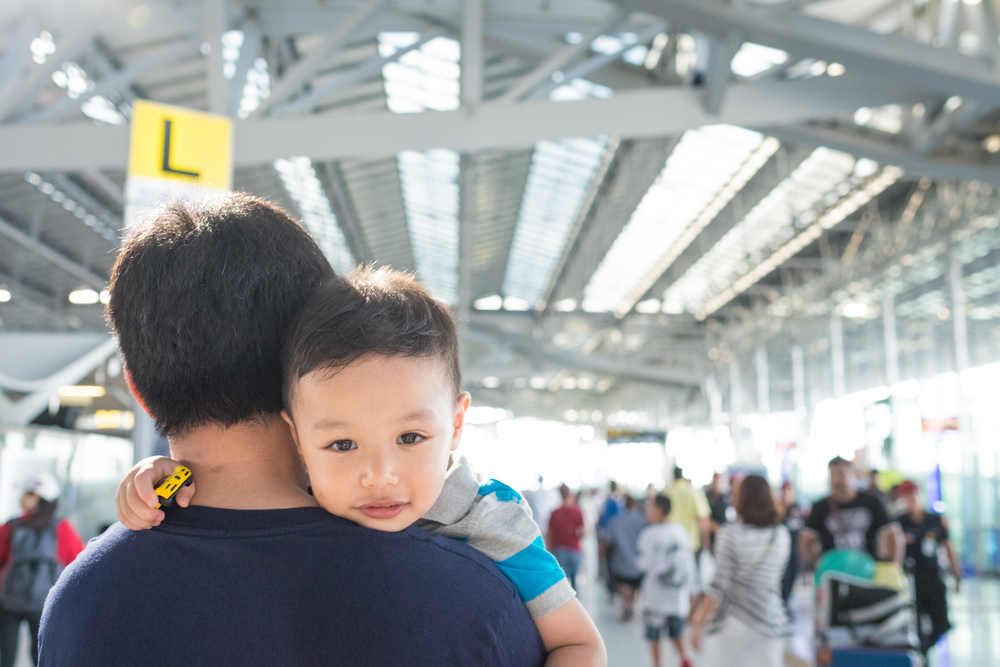Contrary to popular belief, the majority of abductions occur at the hands of parents. Parental child abduction stems from a myriad of factors, primarily rooted in deteriorating relationships, particularly among international partners. Consequently, children become the most vulnerable party in such scenarios, enduring abrupt upheavals with minimal prospects of returning to their country of origin and resuming a stable, nurturing environment conducive to their overall well-being.

Forms of international parental child abduction
International parental child abduction manifests in two forms: wrongful removal and wrongful retention. Wrongful removal transpires when a child is taken out of their home country without the consent of both parents or a court order, while wrongful retention occurs when both parents agree to their child leaving the country for a brief period, such as a holiday, but the child does not return as agreed. In most jurisdictions, only wrongful removal is regarded as a criminal offense (Reunite International, n.d.).
Wrongful removal, also referred to as parental child abduction, occurs when a child is illegally taken from or kept outside their home country, violating the custody rights of the other parent or legal guardian. This action disrupts established custody arrangements and often leads to complicated legal and diplomatic issues because it involves the laws and authorities of multiple countries’ (United States Department of State, n.d.).
The Hague Convention and legal frameworks
Under the Hague Convention on International Child Abduction, specific elements must be satisfied to file a claim of international child abduction. One key element is the age of the child; the Convention applies only if the child is below 16 years of age (Article 4 of the Hague Convention). Even if the child was under 16 at the time of the wrongful removal or retention, the Convention ceases to apply once the child turns 16.
This contrasts with the Convention on the Rights of the Child (CRC), which considers every individual under the age of 18 as a child, leading to legal conflicts and challenges in international child abduction cases. Other necessary elements include the child being habitually resident in one convention country immediately before the breach of custodial rights, and the wrongful removal or retention of the child to or in another convention country.
To address these complexities, the National Incidence Studies of Missing, Abducted, Runaway, and Thrownaway Children (NISMART) conducts Law Enforcement Surveys as part of its mandate under the 1984 Missing Children’s Assistance Act. This act requires the Office of Juvenile Justice and Delinquency Prevention (OJJDP) to periodically determine the number of children reported missing and those recovered each year (Office of Juvenile Justice and Delinquency Prevention, 2023).
One NISMART survey found that the majority of abducted children were under age eight, with approximately 25% being under age four. The data indicated that both the abducting and left-behind parents were generally in their thirties.
In terms of gender, the survey revealed that 58% of abducted children were boys and 42% were girls. It also showed that male abductors were more prevalent (72%) compared to female abductors (28%), with former partners making up the largest portion of male abductors (Chiancone, n.d.).
Challenges of parental child abduction cases
Parental child abduction has evolved into a global concern. However, despite its global prevalence, public awareness of the issue remains surprisingly low. Research commissioned by the Government of the United Kingdom indicates that half of the UK population holds the misconception that the government can intervene and mandate the return of an abducted child to the UK if taken by a parent (Foreign, Commonwealth & Development Office, 2012).
In reality, the process is far more complex. While assistance is indeed available, resolving parental child abduction cases can be a lengthy process, often spanning years. This protracted duration significantly impacts the involved parties, with a real possibility that the child may never be reunited with their custodial parent (Foreign, Commonwealth & Development Office, 2012).

In the United States alone, there are more than 200,000 cases of parental abduction each year that meet the criteria for criminal prosecution. Some abductors are motivated by a fear of losing custody or a desire to gain custody of the child. Because these situations are common and often occur within families experiencing conflict, law enforcement may overlook complaints, attributing them to family disputes, perceived exaggeration, or suspected manipulation for custody purposes (Stoever, 2017).
In the United States specifically, both state and federal courts have jurisdiction over Hague Convention return cases. Therefore, one of the initial strategic decisions for legal counsel is whether to file in state or federal court. However, access cases, where a left-behind parent seeks only access rights (as opposed to custodial rights) to the child, must be filed in state court.
Furthermore, of Africa’s 55 countries, only 11 have ratified the 1980 Hague Convention. Aside from South Africa, which has a significant body of jurisprudence due to numerous cases, there is limited Convention literature and case law across the continent, with minimal information on practical application. Efforts are needed to enhance participation among the other African Convention countries and to encourage the 44 countries not yet party to the Convention to ratify it (Sloth-Nielsen, 2023).
Global strategies for protecting children
The 1980 Hague Convention on Child Abduction, ratified by 103 state parties, provides a legal framework for returning children abducted by a parent. However, the treaty’s effectiveness is a matter of discussion. Not all nations have acceded to the Hague Convention, with some unlikely to do so due to differing interpretations of abduction cases, and cultural norms toward parental and children’s rights. Unfortunately, potential conflicts with certain countries’ legal systems pose challenges to the treaty’s adoption (Hunter, n.d.).
Various nations implement diverse strategies to identify abducted children, prevent adverse outcomes for the child, and apprehend perpetrators. For instance, the United States has implemented stringent measures such as the AMBER Alert system and the Children’s Passport Issuance Alert Program (CPIAP). These initiatives aid in rapidly disseminating information about missing children and ensuring parental consent for passport issuance, respectively.
AMBER Alerts are activated in severe child abduction cases, promptly organizing communities for the safe recovery of missing children. Disseminated via multiple data-enabled devices, this system is implemented across the US and 27 other countries. While each country tailors the system to its specific needs, the overarching objective remains consistent: leveraging public vigilance to aid law enforcement in rescuing endangered children (National Center for Missing & Exploited Children, n.d.).
In addition, the Children’s Passport Issuance Alert Program (CPIAP) in the US promptly notifies parents when a passport application is received for an enrolled child, confirming parental consent for passport issuance. CPIAP also alerts parents about any pending or previous passport applications for the child. During the course of 2023, CPIAP experienced an influx of over 3,700 new enrollments, contributing to a total of more than 66,000 children now protected by the program (Department of State Travel, 2024).
Emotional toll on children

Adding to the gravity of the situation, child victims of international parental kidnapping are often abruptly uprooted from their familiar surroundings and separated from their community, family, and friends. This isolation may result in a prolonged absence from schooling, lasting for months or even years, during a critical stage when children should be developing social, behavioral, and emotional skills. To evade detection or prevent reunification with the other parent, the child may be relocated to multiple undisclosed locations (US Department of Justice, 2023).
Furthermore, the tense and strained relationship between the parents can have a profound emotional impact on the child. Kidnapped children are highly susceptible to developing long-term psychological issues, such as anxiety, mood swings, sleep disturbances, and aggressive behavior. These challenges may persist into adulthood, manifesting in struggles with identity, relationships, and family dynamics (US Department of Justice, 2023).
Due to global shifts in family dynamics and escalating conflicts among couples, the issue has worsened. Disputes arising from parental separations, along with the manipulation of children, lead to more abduction cases, causing lasting harm to minors. Children affected by parental abduction are often caught in their parents’ disputes. Therefore, prioritizing principles like the best interests of the child, as outlined in the Convention on the Rights of the Child, is now more imperative than ever (Martin Gonzales, 2015).
Key to preventing international parental abduction
To increase the likelihood of preventing abduction, it is crucial to adopt proactive measures. Firstly, parents should never assume that their child is immune to abduction, and they should always remain vigilant and prepared for potential risks. Establishing strong communication channels with the child is paramount. Equipping children with essential information such as their full name, address, and telephone number, along with teaching them how to use a telephone, can empower them to seek help when needed (City of Independence, Missouri, n.d.).
Parents should also formalize their parenting agreements through consent orders, an essential step in ensuring clarity and accountability. However, it’s imperative for parents to stay alert, even in seemingly routine activities such as permitting overseas travel by the other parent. Unfortunately, some exploit this trust, taking children to non-signatory countries without intention of return, often with little legal repercussions. Alarmingly, nearly half of Australia‘s abduction cases stem from this scenario (Australian Family Lawyers, n.d.).

Moreover, adopting an Alternative Dispute Resolution (ADR) protocol as part of the Hague Convention could play a vital role in preventing and managing abduction cases. ADR, which includes methods such as mediation and arbitration, offers a less adversarial approach compared to traditional litigation. Therefore, a well-crafted ADR protocol has the potential to minimize the negative impact of prolonged and contentious international child custody battles (Pawlowski, 2007).
Written by Lidija Misic
Internally proofread by Aditi Partha
Last edited on August 19, 2024
Bibliography:
Australian Family Lawyers (n.d.), How to prevent international child abduction from Australia. Retrieved from Australian Family Lawyers at https://www.australianfamilylawyers.com.au/information-centre/preventing-international-child-abduction, accessed on June 12, 2024.
Chiancone Janet (n.d.), Parental Abduction: A Review of the Literature. Retrieved from the Office of Justice Programs at https://www.ojp.gov/pdffiles1/ojjdp/190074.pdf, accessed on June 12, 2024.
City of Independence, Missouri (n.d.), Child Abduction Prevention Tips. Retrieved from City of Independence, Missouri at https://www.independencemo.gov/government/city-departments/police/crime-prevention-education/crime-prevention-tips/preventing-child-abduction, accessed on June 12, 2024.
Department of State Travel (2024), 2024 Annual Report on International Child Abduction. Retrieved from the Department of State Travel at https://travel.state.gov/content/dam/NEWIPCAAssets/pdfs/2024%20Annual%20Report%20International%20Child%20Abduction.pdf, accessed on June 12, 2024.
Foreign, Commonwealth & Development Office (2012), Parental Child Abduction is a worldwide problem. Retrieved from FCDO at https://www.gov.uk/government/news/parental-child-abduction-is-a-worldwide-problem, accessed on June 12, 2024.
Hunter Noelle (n.d.), The Global Problem of International Child Abduction. Retrieved from the University of Alabama at https://www.uah.edu/ahs/departments/political-science/international-child-abduction-prevention-and-research-office/the-global-problem, accessed on June 12, 2024.
Martin Gonzales Nuria (2015), International Parental Child Abduction and Mediation. Retrieved from Anuario Mexicano de Derecho Internacional at https://www.elsevier.es/es-revista-anuario-mexicano-derecho-internacional-74-articulo-international-parental-child-abduction-mediation-S1870465415000112, accessed on June 12, 2024.
National Center for Missing & Exploited Children (n.d.), Amber Alert. Retrieved from NCMEC at https://www.missingkids.org/gethelpnow/amber#internationalamberprograms, accessed on June 12, 2024.
Office of Juvenile Justice and Delinquency Prevention (2023), National Incidence Studies of Missing, Abducted, Runaway, and Thrownaway Children (NISMART), 1999. Retrieved from the Office of Juvenile Justice and Delinquency Prevention at https://catalog.data.gov/dataset/national-incidence-studies-of-missing-abducted-runaway-and-thrownaway-children-nismart-199-2621e, accessed on June 12, 2024.
Pawlowski Radoslaw (2007), Alternative Dispute Resolution for Hague Convention Child Custody Disputes. Retrieved from ResearchGate at https://www.researchgate.net/publication/229808870_ALTERNATIVE_DISPUTE_RESOLUTION_FOR_HAGUE_CONVENTION_CHILD_CUSTODY_DISPUTES, accessed on August 5, 2024.
Reunite International (n.d.), I may have abducted my child. Retrieved from Reunite International at https://www.reunite.org/accused-of-abduction/#:~:text=A%20wrongful%20removal%20is%20when,the%20end%20of%20the%20trip., accessed on June 12, 2024.
Sloth-Nielsen Julia (2023), Chapter 15: International child abduction in Africa. Retrieved from Elgar Online at https://www.elgaronline.com/edcollchap/book/9781800372511/book-part-9781800372511-28.xml, accessed on August 5, 2024.
Stoever K. Jane (2017), Most kidnapped children are taken by a parent. That doesn’t mean they’re safe. Retrieved from The Washington Post at https://www.washingtonpost.com/outlook/most-kidnapped-children-are-taken-by-a-parent-that-doesnt-mean-theyre-safe/2017/07/21/8340cefe-6bc9-11e7-b9e2-2056e768a7e5_story.html, accessed on June 12, 2024.
US Department of Justice (2023), International Parental Kidnapping. Retrieved from US Department of Justice at https://www.justice.gov/criminal/criminal-ceos/international-parental-kidnapping, accessed on June 12, 2024.
United States Department of State (n.d.), International Parental Child Abduction. Retrieved from United States Department of State at https://travel.state.gov/content/travel/en/International-Parental-Child-Abduction.html, accessed on June 12, 2024.

